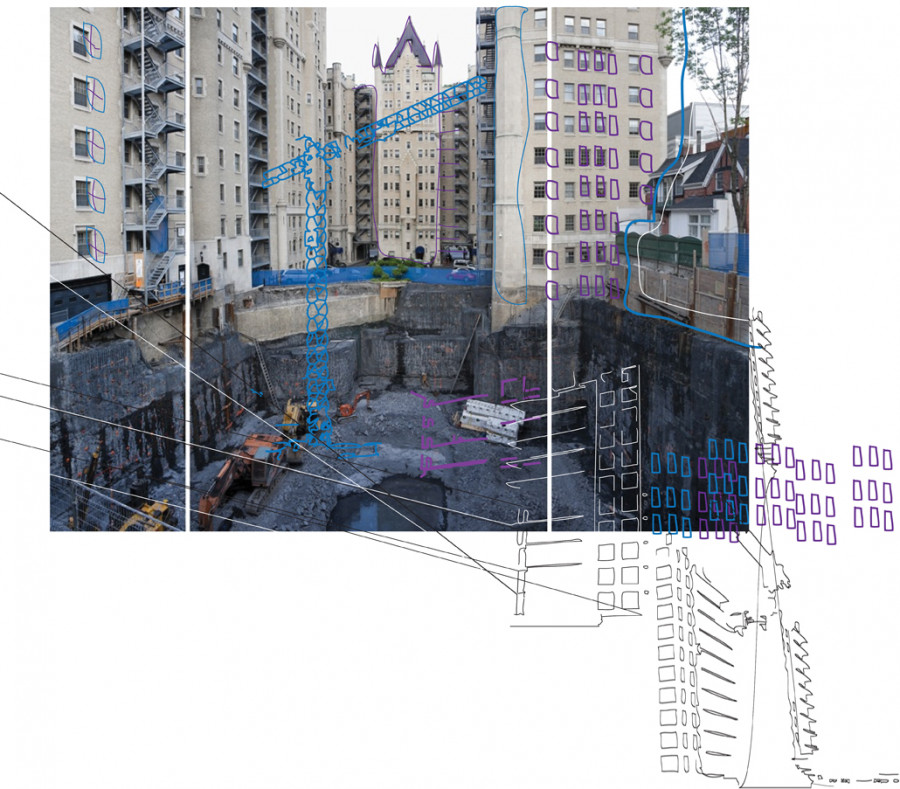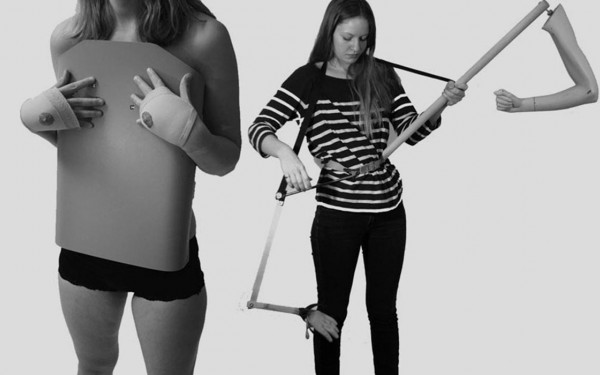Sous la Peau de la Ville: a Reflection on Informal Architecture
Concordia Alumnus Explores the Special Nature of Urban Construction Sites
Montreal’s Centre for Sustainability presents the exhibition Sous la peau de la ville by Linda-Marlena Bucholtz Ross, raising a number of questions on our cultural relation with space and what symbolic meaning there is behind different spatial practices.
Through a series of large-format photographs, multimedia artist and Concordia alumni Linda-Marlena reflects on temporary architecture in the specific context of construction sites.
Describing her work as “capturing the unedited beauty and the unintended aesthetic of the city,” Linda-Marlena offers a perspective on urban construction sites that not only evokes the city’s backstage in its built environment but also brings forward a certain conception of the city and its shape as a living organic entity.
Representing the vector for change and transformation, the site of construction is challenged and questioned in regards to the role it has to play within the cultural and physical landscape.
Alongside the exhibition, a roundtable which brought together the artist Linda-Marlena and three panelists—designers and architects Jean Baptiste Bouillant, Daniel Smith and Kevin Grégoire—focused on the hidden potential of construction sites and the different types of initiatives that could be brought on by the larger public.
Gaëtane Lamarche-Vadel—philosophy of aesthetics professor at the École Nationale Supérieure d’Art in Dijon, France who worked on construction sites in Arsenal—explains that the expression of this mutation can be regarded as an integral component of the city. It should be assessed not only as a nuisance but also as a resource, not simply a phenomenon to dissimulate behind barricades but an area to practice as a living space for metamorphosis.
In her own words,“[Le chantier] peut être regardé comme une composante de la ville à part entière, non pas nuisance mais ressources, non pas phénomène à dissimuler derrière les palissades mais à pratiquer comme lieu vivant des métamorphoses.”
“[Le chantier] peut être regardé comme une composante de la ville à part entière, non pas nuisance mais ressources, non pas phénomène à dissimuler derrière les palissades mais à pratiquer comme lieu vivant des métamorphoses.” — Gaëtane Lamarche-Vadel
Through her artistic interaction with the site, Linda-Marlena transforms architecture. Not only does her art practice shed light on certain issues at stake with urban planning; it also helps redefine how we consider formal and informal architecture.
As a transformative procedure, photography of architecture and, to a larger extent, representations of architecture have their place in the field of architecture.
In order to dig a little bit deeper into the meaning of informal architecture, The Link spoke to Stefan Jovanovic, a professor at Concordia who thoroughly researched the topic for his thesis and later taught a class on the subject in the Fine Arts department. According to him, architecture should be looked at in the widest scope possible to include both the physical construction of a structure but also any intervention to that structure, anything that could add meaning or interact with the structure.
In this case, Linda-Marlena’s approach looks at the means of architecture, the city’s bone structure in its minimal unit and how these means can legitimately qualify as forms of architecture.
Taking the center stage in this exhibition, spatial practice in the everyday life has always had deep political meaning and connotations. By focusing on the construction site which has often times limited public access, the artist demonstrates a conscious desire of showing the invisible, the inaccessible. In a sense, it reveals the impact of physical human interaction on the built environment but also reveals the potential there is for the use of space.
“The most profound political questions have been around this. Wars have been fought over this, as we know it. In the ideology of space, there’s always this idea that, in the human imagination, we always go back to wanting to control space in some ways. This idea that the space has to be controlled, has to be claimed,” said Jovanovic.
In this context, the political resonances in the physical urban landscape are evidently present in other forms such as the presence of monuments in the urban landscape or even in the streets named after political figures.
“There is always a connection between space and power and space has to be overseen by some form of power. When you look at the protest in Egypt, protests in Istanbul, all of them take place in the most symbolic spaces thus giving the protest a symbolic efficiency. Why is that? Because the spaces are symbolic,” he continued.
The theme of the commons—which defines the cultural and natural resources accessible to all—has gained a lot of traction over the recent years in contemporary philosophy. According to Jovanovic, the city space is the modern type of commons and any restriction to this space is a form of enclosure of the commons. “It performs the same thing. It’s dispossessing the masses, the majority, from what should be shared space,” Jovanovic said.
Thus, questioning the use of public space within the construction site framework also resonates with the idea of re-appropriating space and control over shared resources.


_600_832_s.png)

_600_375_90_s_c1.jpg)


_600_375_90_s_c1.jpg)